Introduction
Purchasing power is an important criterion for evaluating a particular market and its sustainability regarding the relationship between supply and demand. If a customer base is large enough, sellers and marketers may rely on substantial profits through the rapid sale of goods. However, in addition to demand parameters, there are other aspects that characterise purchasing power and, at the same time, cannot be predicted and calculated properly. To this type of purchasing, impulse buying refers, which is a separate area of study and research. Such activity has unique features, in particular, unpredictable nature, and it is advantageous for marketers, advertisers, retailers and online deliverers.
In order to analyse the characteristics of impulse purchasing from an academic point of view, a corresponding study will be conducted in Qatar to determine the motives driving customers and the nature of this phenomenon. As a methodology, a quantitative research method will be used, and as a tool, a survey will be utilised. Based on the responses obtained, corresponding statistical reports will be compiled. Such a term as impulse buying may be justified from different positions and criteria, and in each of the cases, the unique features of human habits manifest themselves.
Academic Background
Impulse buying is the area of research that can help determine the nature of unplanned purchases and, thus, understand how consumers are subject to spontaneous desires to acquire a particular product. Suryawardani, Swastika and Hanifa (2017, p. 59) define this phenomenon as widespread and cite the results of the survey of 2012 where they found that 76% of shopping in stores was unplanned. Rook (1987) also considers this term and argues that the parameters of certain products affect consumer interest significantly, forcing them to make spontaneous purchases. In order to consider impulse buying in detail, it is essential to analyse the historical context of its occurrence.
Historical Context of Impulse Purchasing
Scholars began to consider the concept of impulse buying in the 20th century when certain trends were observed that affected unconscious consumer purchases. At the same time, as Shapiro (2015, p. 76) remarks, “after 40 years of research, impulse buying is still a poorly understood concept”. Despite significant progress in the field of merchandising research and consumer psychology, it is hard enough to trace the characteristic motifs and factors that uniquely affect the interests of the target audience. In the 21st century, researchers began to pay great attention to the influence of various media as stimulating factors, and Aragoncillo and Orus (2018) view this trend in the context of social networks. Kalla and Arora (2011) focus on a psychological background and also explore impulse buying in a historical context. In general, much attention is paid to this phenomenon in academic literature, despite its insufficiently disclosed nature.
Nature of Impulse Buying
Impulse buying is one of the consequences of internal behavioural motives and habits. According to Watson and Tellegen (1985), certain moods play an essential role in the perception of certain goods and the desire to purchase them. Identically, Hansen (2005) considers the nature of the consumer decision-making process and argues that an emotional component performs an important function in the spontaneous selection of particular products. O’Brien (2010, p. 344) introduces the concept of hedonic needs that consumers are willing to meet, for instance, “affect, social interaction and/or entertainment”. Accordingly, marketers, sellers, advertisers, and other stakeholders utilise these nuances in order to generate a certain interest and influence the preferences of the target audience (Solomon et al. 2016). Woodruffe-Burton, Eccles and Elliott (2002) consider the theory of shopping in general and note that analysing consumers’ subconscious habits and applying this knowledge form the driving force of sales. Therefore, the nature of impulse buying is complex and multifaceted.
Factors Influencing Impulse Behaviour
When considering the topic of impulse purchasing, it is crucial to investigate the factors that influence specific consumer behaviour and serve as stimuli. Dittmar, Beattie and Friese (1996) argue that social/environmental criteria are the basis of such preferences and divide them according to individual needs and belonging to a social group – gender, age, and other aspects. Dittmar (2005, p. 833) states that there are such main factors as “materialistic value endorsement and perceived identity deficits”. In general, all the criteria may be divided into two large groups – internal and external. As Kollat and Willett (1967) note, age and gender are the most significant factors in this category, and according to the results of their research, women are more prone to impulse buying. Bayley and Nancarrow (1998) emphasise the relevance of self-image as an internal motivator and remark that many purchases are made under the influence of this aspect. This statement makes sense since the nature of acquisitions often reflects the individuality of buyers.
Regarding external factors, advertisers and marketers use different forms of attracting consumer interest. According to Aslam (2006), such a parameter as colour may be a valuable tool for influencing consumers’ desires, affecting their subconscious choice of products. Kalla and Arora (2011) also look at external factors and point out promotional discounts, visual incentives, certain self-service formats, and some other methods. Chen and Wang (2016) support these factors and note that, for instance, cash refund promotion programmes can increase sales intensity. In general, the motivational perspective is a key driving force, and consumer behaviour in terms of social psychology is one of the aspects of market demand analysis (Xu 2008). As a result, many factors have been found, which allows conducting the planned research and assess the predominance of specific aspects of impact.
Research Process
The planned study aims at determining how much the residents of Qatar are prone to impulse purchases and how many respondents are subject to the aforementioned influences. According to Zhou and Wong (2004), in order to analyse the interest in spontaneous buying, it is essential to utilise a sufficiently large number of participants to compile appropriate statistical reports. This fact should be taken into account to achieve the credibility of the study and obtain the most accurate results. It is also crucial to choose the right methodology, the sample of the research, key issues, and evaluate the findings based on them. Also, some limitations should be mentioned to eliminate bias and concentrate on the range of a research framework.
Methodology
The planned study provides for close contact with the population, and the key goal is the need to find out the ratio of individual categories in relation to the factors affecting impulse purchasing. For this purpose, a qualitative research method is an optimal mechanism to conduct all the necessary comparative procedures and identify specific correlations. As an analysis tool, semi-structured interviews will be utilised in order to obtain the most accurate information from consumers. 14 questions will be asked to 28 respondents, and all of them will be related to the notion of impulse buying and the motivations that encourage them to certain acquisitions. Based on the responses, it is assumed that graphical charts will be compiled to display the results visually and compare the prevalence of certain behavioural patterns. As evaluation criteria, such components will be applied as the frequency of shopping, places of visits, the types of goods purchased impulsively, the time of the day for purchases, payment methods, and stimulating factors. In accordance with this comprehensive assessment, conclusions will be made regarding the prevailing impacts and trends.
Sampling Method
Since it is problematic to conduct the selection of study participants throughout the country, a convenience method will be used as a sampling principle. The estimated number of research members is 28 people, including 26 females and 2 males. The selection method aims at surveying those people who are available and can answer questions freely. Family members and friends will be involved to become the target audience, and their consent to participate in the study is voluntary. Although Wicklund and Gollwitzer (1981) note that the background of survey members is a significant aspect of analysing preferences regarding impulse purchases, this criterion will not be taken into account. Since a limited number of participants will be engaged, they will not be grouped by a specific attribute, and gender is the only dependent variable of the sample.
Key Findings
To begin with, shopping frequency indicators will be reviewed and assessed based on the responses of the respondents. According to Wu, Chen and Chiu (2016), this indicator makes it possible to assess the propensity for impulsiveness since permanent acquisitions increase the likelihood of spontaneous purchases. As criteria, 5 basic options are proposed – once a week, twice a week, three times a week, every day, or once a month. Figure 1 displays the analysed results in accordance with the responses obtained.
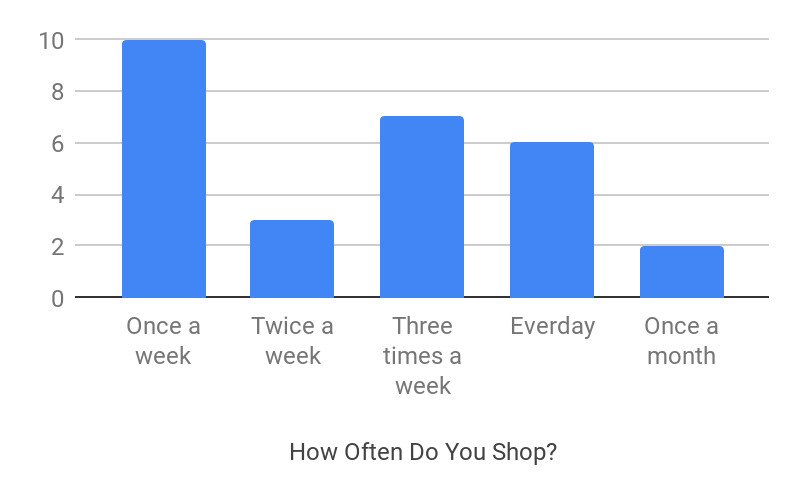
Another evaluation criterion is preferred shopping places chosen as per customer responses. As such facilities, malls, supermarkets, online stores, libraries, and pharmacies are offered. Despite the fact that today, online shopping is common, the vast majority of respondents (75%) prefer to shop offline. As Soars (2009) remarks, marketplaces often stimulate impulse buying due to the abundance of the products of different profiles and the availability of purchasing. In Figure 2, the data ratio is displayed where it is possible to see how preferences are distributed.
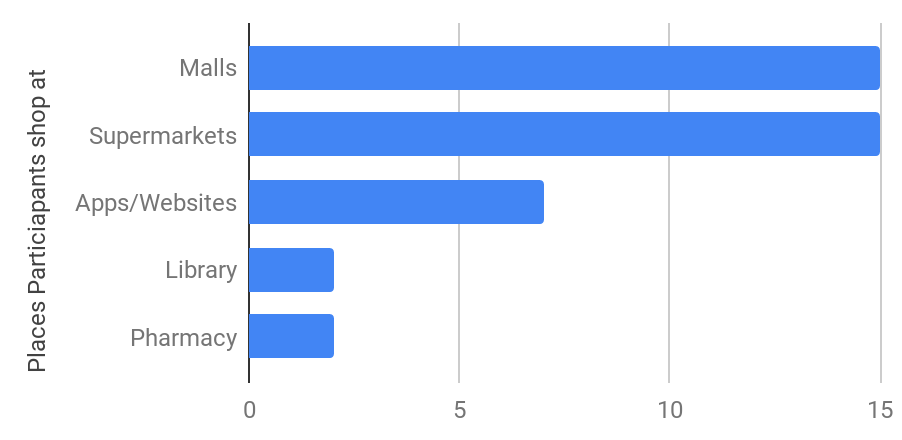
To evaluate the following factor, the respondents’ views are necessary on what purchases, in their opinion, they make on an impulsive basis. Kopetz, Woerner and Briskin (2018) suggest paying attention to the term of strategic behaviour and note that marketers are quite efficient in controlling consumer motivation by creating interest in certain categories of goods. Figure 3 reflects the respondents’ tendency toward specific types of purchases and proves that food products are in demand.
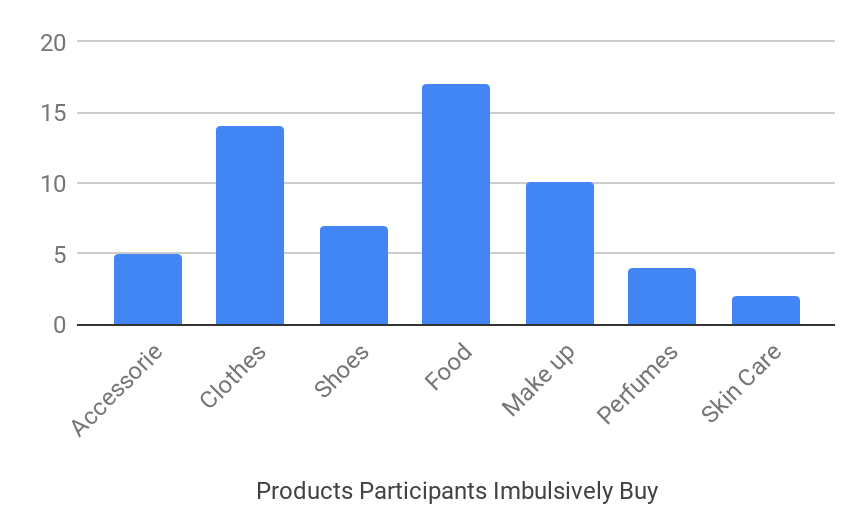
When analysing the tendency of respondents to impulse purchasing, such a criterion should be applied as the time of the day. This factor often plays a significant role because at different periods, people behave distinctively in a shopping environment. Crawford and Melewar (2003) give an example of the situation from the sphere of civil aviation and emphasise that a greater number of ticket orders occur in the evening when people are more tired. Figure 4 proves such a theory and shows that respondents also tend to make an impulse to buy at the end of the day.
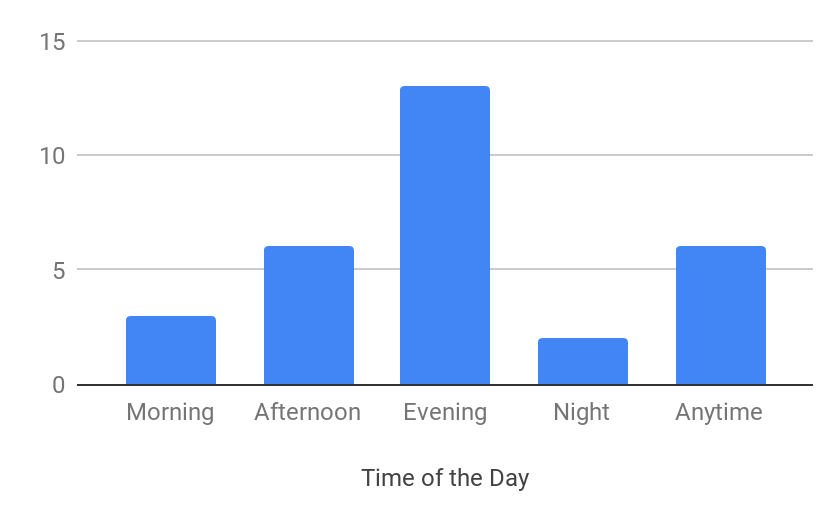
Finally, as a tool for visual displaying, factors affecting impulse purchasing are analysed. According to the responses obtained, the most significant criterion is the atmosphere in which goods are bought. Discounts and convenience also play an important role, but some research participants note that they are not subjected to any influences. As Arnould, Price and Zinkhan (2002) note, sales are still one of the main drivers of impulse buying, and Figure 5 proves this assumption.
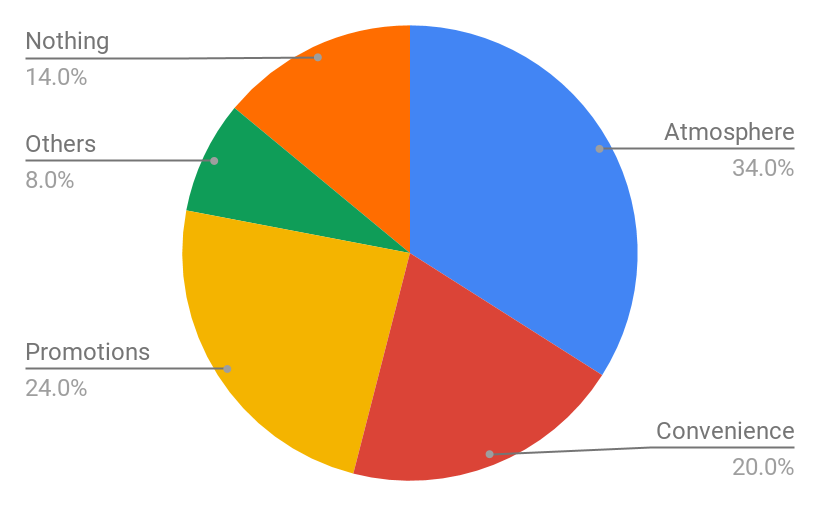
Based on the results obtained, it can be argued that impulse buying is a significant phenomenon in the field of marketing because the frequency of spontaneous purchases largely forms the demand for certain goods. The relevance of the study lies in the fact that its data allow reflecting the tendency of Qatar’s residents to commit spontaneous purchases. In the middle of the 20th century, Stern (1962) considered this propensity and argued that impulse buying could have weighty implications for the trade area. As the results of the study show, this assumption does not lose its relevance today.
Constraints and Limitations
Despite sufficiently detailed information regarding the preferences of the respondents, the study has some limitations. In particular, the results of a small group are analysed due to the convenience sampling method. Also, the research does not affect the comparison of preferences regarding Qatar’s internal market and foreign products. According to Carter and Maher (2015), modelling the situation involving the propensity to buy the goods of foreign origin allows making rational conclusions regarding the quality of the local sales sphere. In general, the research method is consistent with the nature of the work carried out and, despite some limitations, the outcomes may have practical significance. With regard to marketing, the survey results can be used to promote food products as one of the most popular categories of goods bought impulsively.
Conclusion
The concept of impulse buying can be considered from different standpoints, and behavioural aspects play an essential role in forming people’s propensity for spontaneous purchases. The study confirms many of the findings of academic sources and proves that the motives that stimulate people to acquire certain goods are largely based not only on internal but also external factors. Applied to impulse purchasing in Qatar, the survey results prove that many respondents are exposed to various influences that have an effect on their interest in products. Based on the evaluation facts, food products are the category where spontaneous purchases are the most frequent. The value of this study lies in its importance to marketers, advertisers, retailers and other stakeholders due to an opportunity to control demand and influence customer interests. There are some limitations that constrain the significance of the research. As further work, a wider sample may be applied to achieve the goal more accurately and determine the number of Qatar residents who are prone to impulse buying.
Reference List
Aragoncillo, L & Orus, C 2018, ‘Impulse buying behaviour: an online-offline comparative and the impact of social media’, Spanish Journal of Marketing – ESIC, vol. 22, no. 1, pp. 42-62.
Arnould, EJ, Price, L & Zinkhan, GM 2002, Consumers. McGraw-Hill/Irwin, New York, NY.
Aslam, MM 2006, ‘Are you selling the right colour? A cross-cultural review of colour as a marketing cue’, Journal of Marketing Communications, vol. 12, no. 1, pp. 15-30.
Bayley, G & Nancarrow, C 1998, ‘Impulse purchasing: a qualitative exploration of the phenomenon’, Qualitative Market Research: An International Journal, vol. 1, no. 2, pp. 99-114.
Carter, LL & Maher, AA 2015, ‘Consumer perceptions of foreign goods: modeling the path from evaluation to purchase’, Journal of Marketing Development & Competitiveness, vol. 9, no. 1, pp. 32-49.
Chen, YF & Wang, RY 2016, ‘Are humans rational? Exploring factors influencing impulse buying intention and continuous impulse buying intention’, Journal of Consumer Behaviour, vol. 15, no. 2, pp. 186-197.
Crawford, G & Melewar, TC 2003, ‘The importance of impulse purchasing behaviour in the international airport environment’, Journal of Consumer Behaviour: An International Research Review, vol. 3, no. 1, pp. 85-98.
Dittmar, H, Beattie, J & Friese, S 1996, ‘Objects, decision considerations and self-image in men’s and women’s impulse purchases’, Acta Psychologica, vol. 93, no. 1-3, pp. 187-206.
Dittmar, H 2005, ‘A new look at “compulsive buying”: self-discrepancies and materialistic values as predictors of compulsive buying tendency’, Journal of Social and Clinical Psychology, vol. 24, no. 6, pp. 832-859.
Hansen, T 2005, ‘Perspectives on consumer decision making: an integrated approach’, Journal of Consumer Behaviour: An International Research Review, vol. 4, no. 6, pp. 420-437.
Kalla, SM & Arora, AP 2011, ‘Impulse buying: a literature review’, Global Business Review, vol. 12, no. 1, pp. 145-157.
Kollat, DT & Willett, RP 1967, ‘Customer impulse purchasing behavior’, Journal of Marketing Research, vol. 4, no. 1, pp. 21-31.
Kopetz, CE, Woerner, JI & Briskin, JL 2018, ‘Another look at impulsivity: could impulsive behavior be strategic?’, Social and Personality Psychology Compass, vol. 12, no. 5, p. e12385.
O’Brien, HL 2010, ‘The influence of hedonic and utilitarian motivations on user engagement: the case of online shopping experiences’, Interacting with Computers, vol. 22, no. 5, pp. 344-352.
Rook, DW 1987, ‘The buying impulse’, Journal of Consumer Research, vol. 14, no. 2, pp. 189-199.
Shapiro, JM 2015, ‘Impulse buying: a new framework’, Proceedings of the 1992 Academy of Marketing Science (AMS) Annual Conference, Springer, Switzerland, pp. 76-80.
Soars, B 2009, ‘Driving sales through shoppers’ sense of sound, sight, smell and touch’, International Journal of Retail & Distribution Management, vol. 37, no. 3, pp. 286-298.
Solomon, MR, Bamossy, G, Askegaard, S & Hogg, MK 2016, Consumer behavior: a European perspective, 6th edn, Pearson Education, London.
Stern, H 1962, ‘The significance of impulse buying today’, Journal of Marketing, vol. 26, no. 2, pp. 59-62.
Suryawardani, B, Sastika, W & Hanifa, FH 2017, ‘Impulsive buying behavior in Bandung: external and internal stimuli’, Bandung: Pertanika Journal Social Sciences & Humanities, vol. 25, pp. 59-68.
Watson, D & Tellegen, A 1985, ‘Toward a consensual structure of mood’, Psychological Bulletin, vol. 98, no. 2, pp. 219-235.
Wicklund, RA & Gollwitzer, PM 1981, ‘Symbolic self-completion, attempted influence, and self-deprecation’, Basic and Applied Social Psychology, vol. 2, no. 2, pp. 89-114.
Woodruffe-Burton, H, Eccles, S & Elliott, R 2002, ‘Towards a theory of shopping: a holistic framework’, Journal of Consumer Behaviour: An International Research Review, vol. 1, no. 3, pp. 256-266.
Wu, L, Chen, KW & Chiu, ML 2016, ‘Defining key drivers of online impulse purchasing: a perspective of both impulse shoppers and system users’, International Journal of Information Management, vol. 36, no. 3, pp. 284-296.
Xu, Y 2008, ‘The influence of public self-consciousness and materialism on young consumers’ compulsive buying’, Young Consumers, vol. 9, no. 1, pp. 37-48.
Zhou, L & Wong, A 2004, ‘Consumer impulse buying and in-store stimuli in Chinese supermarkets’, Journal of International Consumer Marketing, vol. 16, no. 2, pp. 37-53.